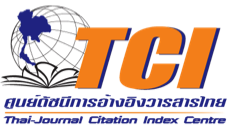Knowledge, Behaviors, and Participation in Surveillance, Prevention, and Control of Coronavirus Disease 2019 (COVID-19) in Thai-Myanmar Border Communities: A Case Study
DOI:
https://doi.org/10.1016/hscr.v39i2.269456Keywords:
knowledge, Behaviors, Participation, Surveillance and Prevention for Covid 19, border communityAbstract
Objective: This study aims to compare the levels of knowledge, practices, and participation surveillance,
prevention, and control of Coronavirus Disease 2019 (COVID-19) between the Thailand-Myanmar border communities in Mae Sai, Chiang Rai province, and Mae Sot, Tak province.
Method: This study employed a cross-sectional descriptive research design with a sample of 400 participants. The sample comprised household representatives aged 18 years and above residing in Thai-Myanmar border communities: 200 from Mae Sai District, Chiang Rai Province, and 200 from Mae Sot District, Tak Province. Participants were selected using area-based stratified random sampling proportional to the population size, focusing on sub-districts adjacent to the Thai-Myanmar border. The research instrument was a questionnaire assessing knowledge, practices, and participation in surveil
lance, prevention, and control of Coronavirus Disease 2019 (COVID-19) in Thai-Myanmar bordercommunities.
Data analysis involved descriptive statistics to characterize demographic features, chi-square test, Fisher’s exact test, and independent t-test for comparative analysis between the two sample groups from different areas.
Results: The majority of participants in both areas demonstrated a high level of knowledge about Coronavirus Disease 2019 (COVID-19), moderate level of preventive practices, and high community participation. Comparison of mean scores between the two areas revealed a statistically significant difference in participation in surveillance, prevention, and control of COVID-19 in the community
(p=0.018) at the 0.05 significance level. Furthermore, demographic characteristics including ethnicity (p<.001), occupation (p=.007), income (p<.001), healthcare coverage (p<.001), duration of community residence (p=.005), and community role (p<.001) showed statistically significant differences between the two sample groups at the .05 significance level.
Conclusions: Although participation in surveillance, prevention, and control of Coronavirus Disease
2019 (COVID-19) varied between communities, the majority of participants in both areas demonstrated comparable levels of knowledge and preventive practices. To ensure sustainable community participation in disease surveillance and prevention, relevant agencies should foster cooperation between communities, officials, and technology. This approach aims to empower communities and develop innovations leading to resilient communities prepared to handle future emergencies.
References
World Health Organization. รายงานความคืบหน้าประจำสัปดาห์ในประเทศไทย โดยองค์การอนามัยโลก ฉบับที่ 221;2022.
ทวิติยา สุจริตรักษ์. ประเด็นน่ารู้เกี่ยวกับไวรัส SARSCoV-2: ไวรัสที่ก่อให้เกิดโรคโควิด-19 [Internet]. 2564 [cited2024 Dec 16]. Available from: https://pidst.or.th/A966.html
ปิยะนันท์ เรือนคำ, สุคนธา คงศีล, สุขุม เจียมตน, ยุวนุช สัตยสมบูรณ์, เพ็ญพักตร์ อุทิศ. ปัจจัยที่มีความสัมพันธ์กับพฤติกรรมการป้องกันโรคติดเชื้อไวรัสโคโรนา 2019 ของประชากรผู้ใหญ่: กรณีศึกษาเขตจอมทอง กรุงเทพมหานคร. วารสารวิชาการสาธารณสุข. 2565;31(2):s247-s59.
Castelli F, Sulis G. Migration and infectious diseases. Clin Microbiol Infect. 2017;23(5):283-9.
Institute of Medicine (US) Forum on Microbial Threats; Knobler S, Lemon S, et al., editors. The impact of globalization on infectious disease emergence and control: exploring the consequences and opportunities: workshop summary [Internet]. Washington (DC): National Academies Press (US); 2006 [cited 2024 Dec 16]. Available from: https://www.ncbi.nlm.nih.gov/books/NBK56593/
Morita S, Nakagawa K. Evaluating the impact of human flow on the spread of infectious diseases. J Theor Biol. 2023;558:111367.
Morse SS. Factors in the emergence of infectious diseases. Emerg Infect Dis. 1995;1(1):7-15.
GISTDA. “เร็วคือรอด” [Internet]. 2020 [updated 2020 Sep 15; cited 2024 Dec 16]. Available from: https:// www.gistda.or.th/news_view.php?n_id=2294&lang=EN
ไทยรัฐออนไลน์. เลาะรั้วชายแดนสกัด “โควิด” ปรับแผนสู้ หวั่นระบาดรอบ 2 ไทยเจ๊ง! [Internet]. 2563 [updated 2020 Dec 10; cited 2024 Dec 16]. Available from: https://www.thairath.co.th/news/local/1991833
ละเอียด ศิลาน้อย. การใช้สูตรทางสถิติ (ที่ถูกต้อง) ในการกำหนดขนาดของกลุ่มตัวอย่างเพื่อการวิจัยเชิงปริมาณในทางมนุษยศาสตร์และสังคมศาสตร์. วารสารวิจัยและพัฒนามหาวิทยาลัยราชภัฏบุรีรัมย์. 2560;12(2):50-61.
ธารทิพย์ ธรรมสอน, สมเกียรติ ชัยพิบูลย์. การวิจัยเชิงปฏิบัติการแบบมีส่วนร่วมของชุมชนในการจัดการสิ่งแวดล้อมเมืองการค้าชายแดนแม่สอด อำเภอแม่สอด จังหวัดตาก. สักทองสารสารการวิจัย. 2553;16(1):30-43.
ปรีชา อุปโยคิน, พลวัฒ ประพัฒน์ทอง, ภัทรา ชลดำรงค์กุล. ความหลากหลายกลุ่มชาติพันธุ์กับการพัฒนาเศรษฐกิจชายแดน ในอำเภอแม่สาย จังหวัดเชียงราย. วารสารสังคมศาสตร์ คณะรัฐศาสตร์ จุฬาลงกรณ์มหาวิทยาลัย. 2560;47(1):81-105.
แพรพรรณ ภูริบัญชา, เชิดพงษ์ มงคลสินธุ์, ปวีณาจังภูเขียว. การพัฒนารูปแบบการเฝ้าระวัง ป้องกันและควบคุมโรคติดเชื้อไวรัสโคโรนา 2019 ในพื้นที่เฉพาะ (Bubble and Seal)ของสถานประกอบการ จังหวัดมหาสารคาม. วารสารวิชาการสาธารณสุข. 2565;31(1).
ระนอง เกตุดาว, อัมพร เที่ยงตรงดี, ภาสินี โทอินทร์. การพัฒนารูปแบบการเฝ้าระวัง ป้องกันและควบคุมโรคติดเชื้อไวรัสโคโรนา 2019 โรงพยาบาลส่งเสริมสุขภาพตำบล จังหวัดอุดรธานี - Udon Model COVID-19. วารสารวิชาการสาธารณสุข. 2564;30(1):53-61.
Tjahjadi B, Soewarno N, Adibah Wan IsmailW, Kustiningsih N, Nasihatun Nafidah L. Community
behavioral change and management of COVID-19 pandemic:evidence from Indonesia. J King Saud Univ Sci.2023;35(2):102451.
ปองขวัญ สร่างทุกข์, เจนนภนต์ ภาคภูมิ, พิภพมณีจำนงค์, อิทธิโชตน์ โชติกุณฑ์พันธุ์. โครงการสำรวจการปรับตัวของชุมชนวิถีใหม่ในสถานการณ์การระบาดของโรคโควิด-19 จังหวัดน่าน. วารสารชุมชนวิจัย มหาวิทยาลัยราชภัฏนครราชสีมา.2565;16(3):97-110.
ทนงศักดิ์ แสงสว่างวัฒนะ, ณิชนันทน์ ศิริไสยาสน์, โชติบดีรัฐ. “New Normal” วิถีชีวิตใหม่และการปรับตัวของคนไทยหลังโควิด-19: การงาน การเรียน และธุรกิจ. วารสารการบริหารการปกครองและนวัตกรรมท้องถิ่น. 2563;4(3):371-86.
ดรุณี โพธิ์ศรี, เอกลักษณ์ เอี่ยมประดิษฐ์, เอกพล เสมาชัย.การเฝ้าระวัง และควบคุมโรคโควิด-19: การมีส่วนร่วมของทุกภาคส่วนเพื่อจัดการสถานการณ์ฉุกเฉินด้านสาธารณสุข จังหวัดนครปฐม. วารสารวิชาการสาธารณสุข. 2566;32(1):49-60.
วลีรัตน อภัยบัณฑิตกุล. การพัฒนาระบบและกลไกการเฝ้าระวัง ป้องกัน และควบคุมโรคในสถานการณ์การระบาดของโรคติดเชื้อโควิด 19 ในเครือข่ายสุขภาพจังหวัดอุบลราชธานี. วารสารวิจัยและพัฒนานวัตกรรมทางสุขภาพ. 2565;3(2):55-71.
Downloads
Published
How to Cite
Issue
Section
License
Copyright (c) 2024 Health Science Clinical Research

This work is licensed under a Creative Commons Attribution-NonCommercial-NoDerivatives 4.0 International License.
The names and email addresses entered in this journal site will be used exclusively for the stated purposes of this journal and will not be made available for any other purpose or to any other party.















